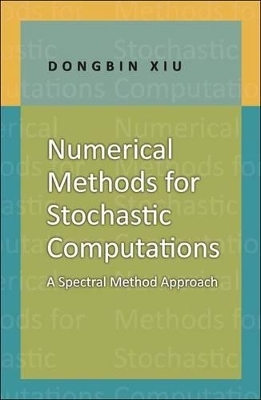
Numerical Methods for Stochastic Computations
Princeton University Press (Verlag)
978-0-691-14212-8 (ISBN)
The@ first graduate-level textbook to focus on fundamental aspects of numerical methods for stochastic computations, this book describes the class of numerical methods based on generalized polynomial chaos (gPC). These fast, efficient, and accurate methods are an extension of the classical spectral methods of high-dimensional random spaces. Designed to simulate complex systems subject to random inputs, these methods are widely used in many areas of computer science and engineering. The book introduces polynomial approximation theory and probability theory; describes the basic theory of gPC methods through numerical examples and rigorous development; details the procedure for converting stochastic equations into deterministic ones; using both the Galerkin and collocation approaches; and discusses the distinct differences and challenges arising from high-dimensional problems. The last section is devoted to the application of gPC methods to critical areas such as inverse problems and data assimilation.
Ideal for use by graduate students and researchers both in the classroom and for self-study, Numerical Methods for Stochastic Computations provides the required tools for in-depth research related to stochastic computations. * The first graduate-level textbook to focus on the fundamentals of numerical methods for stochastic computations * Ideal introduction for graduate courses or self-study * Fast, efficient, and accurate numerical methods * Polynomial approximation theory and probability theory included * Basic gPC methods illustrated through examples
Dongbin Xiu is associate professor of mathematics at Purdue University.
Preface xi Chapter 1: Introduction 1 1.1 Stochastic Modeling and Uncertainty Quantification 1 1.1.1 Burgers' Equation: An Illustrative Example 1 1.1.2 Overview of Techniques 3 1.1.3 Burgers' Equation Revisited 4 1.2 Scope and Audience 5 1.3 A Short Review of the Literature 6 Chapter 2: Basic Concepts of Probability Theory 9 2.1 Random Variables 9 2.2 Probability and Distribution 10 2.2.1 Discrete Distribution 11 2.2.2 Continuous Distribution 12 2.2.3 Expectations and Moments 13 2.2.4 Moment-Generating Function 14 2.2.5 Random Number Generation 15 2.3 Random Vectors 16 2.4 Dependence and Conditional Expectation 18 2.5 Stochastic Processes 20 2.6 Modes of Convergence 22 2.7 Central Limit Theorem 23 Chapter 3: Survey of Orthogonal Polynomials and Approximation Theory 25 3.1 Orthogonal Polynomials 25 3.1.1 Orthogonality Relations 25 3.1.2 Three-Term Recurrence Relation 26 3.1.3 Hypergeometric Series and the Askey Scheme 27 3.1.4 Examples of Orthogonal Polynomials 28 3.2 Fundamental Results of Polynomial Approximation 30 3.3 Polynomial Projection 31 3.3.1 Orthogonal Projection 31 3.3.2 Spectral Convergence 33 3.3.3 Gibbs Phenomenon 35 3.4 Polynomial Interpolation 36 3.4.1 Existence 37 3.4.2 Interpolation Error 38 3.5 Zeros of Orthogonal Polynomials and Quadrature 39 3.6 Discrete Projection 41 Chapter 4: Formulation of Stochastic Systems 44 4.1 Input Parameterization: Random Parameters 44 4.1.1 Gaussian Parameters 45 4.1.2 Non-Gaussian Parameters 46 4.2 Input Parameterization: Random Processes and Dimension Reduction 47 4.2.1 Karhunen-Loeve Expansion 47 4.2.2 Gaussian Processes 50 4.2.3 Non-Gaussian Processes 50 4.3 Formulation of Stochastic Systems 51 4.4 Traditional Numerical Methods 52 4.4.1 Monte Carlo Sampling 53 4.4.2 Moment Equation Approach 54 4.4.3 Perturbation Method 55 Chapter 5: Generalized Polynomial Chaos 57 5.1 Definition in Single Random Variables 57 5.1.1 Strong Approximation 58 5.1.2 Weak Approximation 60 5.2 Definition in Multiple Random Variables 64 5.3 Statistics 67 Chapter 6: Stochastic Galerkin Method 68 6.1 General Procedure 68 6.2 Ordinary Differential Equations 69 6.3 Hyperbolic Equations 71 6.4 Diffusion Equations 74 6.5 Nonlinear Problems 76 Chapter 7: Stochastic Collocation Method 78 7.1 Definition and General Procedure 78 7.2 Interpolation Approach 79 7.2.1 Tensor Product Collocation 81 7.2.2 Sparse Grid Collocation 82 7.3 Discrete Projection: Pseudospectral Approach 83 7.3.1 Structured Nodes: Tensor and Sparse Tensor Constructions 85 7.3.2 Nonstructured Nodes: Cubature 86 7.4 Discussion: Galerkin versus Collocation 87 Chapter 8: Miscellaneous Topics and Applications 89 8.1 Random Domain Problem 89 8.2 Bayesian Inverse Approach for Parameter Estimation 95 8.3 Data Assimilation by the Ensemble Kalman Filter 99 8.3.1 The Kalman Filter and the Ensemble Kalman Filter 100 8.3.2 Error Bound of the EnKF 101 8.3.3 Improved EnKF via gPC Methods 102 Appendix A: Some Important Orthogonal Polynomials in the Askey Scheme 105 A.1 Continuous Polynomials 106 A.2 Discrete Polynomials 108 Appendix B: The Truncated Gaussian Model G(a?, ?ss) 113 References 117 Index 127
| Zusatzinfo | 50 line illus. |
|---|---|
| Verlagsort | New Jersey |
| Sprache | englisch |
| Maße | 152 x 235 mm |
| Gewicht | 340 g |
| Themenwelt | Mathematik / Informatik ► Informatik ► Theorie / Studium |
| Mathematik / Informatik ► Mathematik ► Analysis | |
| Mathematik / Informatik ► Mathematik ► Angewandte Mathematik | |
| ISBN-10 | 0-691-14212-2 / 0691142122 |
| ISBN-13 | 978-0-691-14212-8 / 9780691142128 |
| Zustand | Neuware |
| Haben Sie eine Frage zum Produkt? |
aus dem Bereich


